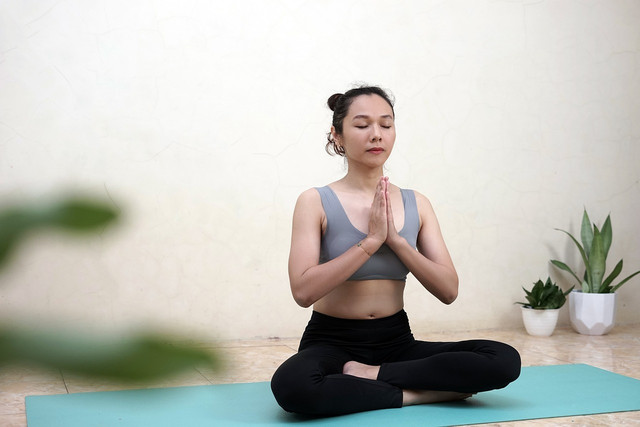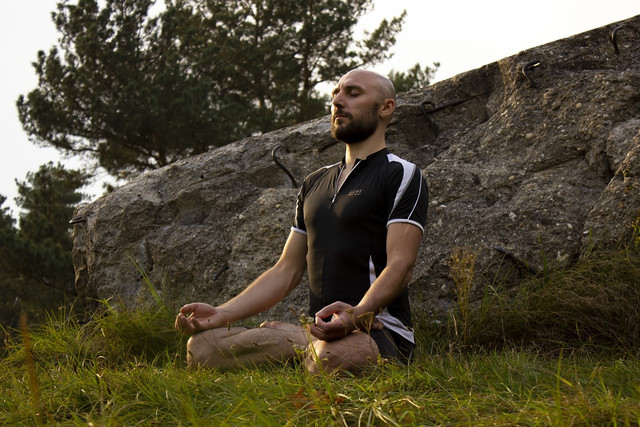Conscious breathing focuses your attention on your breath and can be used as a tool to improve your physical, mental, and emotional well-being. Learn how here.
Conscious breathing involves taking deep breaths, inhaling and exhaling both slowly and fully, and staying present and aware of the sensations in your body. This practice can be used alone or as part of other mindfulness practices, such as meditation or hatha yoga.
Breathing deeply can have many benefits, including reducing stress and anxiety, improving focus and concentration, and promoting relaxation and better sleep. You can also activate the body’s natural relaxation response by paying attention to your breath and consciously controlling it. This can help counteract the effects of stress on your physical and mental health. We’ll take a closer look at conscious breathing and how you can benefit.
What is Conscious Breathing?



While there are many methods, such as the 4-7-8 technique, conscious breathing was not invented by one person or organization. It is a practice that has been used for centuries in different ways and has been part of many spiritual and wellness traditions around the world, such as:
- In yoga, pranayama is the practice of working with the breath to increase energy, focus, and relaxation.
- In Taoist traditions, there are practices like qigong and tai chi that use breathing techniques to improve health and well-being.
- Many indigenous cultures have their own traditional practices that use conscious breathing to heal and be spiritual.
In recent years, there has been growing interest in conscious breathing as a way to promote health and wellness. There are now many teachers and organizations that offer workshops, classes, and resources on conscious breathing techniques, and research is being done on the benefits of these practices.
Benefits of the Technique



Research has shown that practicing conscious breathing techniques can improve your health. These are some key benefits backed up by scientific studies:
- Counteracting the effects of stress and anxiety. Studies have shown that practicing conscious breathing techniques regularly can lower cortisol levels and reduce symptoms of anxiety and depression.
- Improving focus and concentration by increasing the flow of oxygen to your brain, improving mental clarity and cognitive performance.
- Relaxation and better sleep. Some studies have shown that practicing conscious breathing techniques before bed can help to improve sleep quality for people suffering from insomnia and disrupted sleep breathing. For best results, use conscious breathing in combination with a relaxing tea.
- Reducing blood pressure by relaxing the blood vessels and improving circulation.
- Increasing athletic performance by increasing lung capacity, increasing oxygen uptake, and reducing fatigue. Many athletes utilize breathing techniques to improve their endurance and focus during training and competition, but it’s just as useful during your daily walk.
How Can Conscious Breathing Change Your Outlook?
In addition to physical benefits, there are many reported mental health benefits of conscious breathing, these include:
- Increased mindfulness. Focusing on the present moment with curiosity and non-judgment through conscious breathing can help you become more mindful of your thoughts, feelings, and surroundings. Mindfulness can help you shift your perspective and be more open to new experiences and ideas.
- Improved emotional resilience and regulation. Conscious breathing can help you better manage your thoughts and feelings by letting you see and feel them more clearly. Regularly practicing conscious breathing can teach you to recognize your emotional triggers and respond to them in a more thoughtful and balanced way. This can help you have a more positive and flexible outlook on life.
- Greater self-awareness. Tuning into your breath and body can help you learn more about your needs, values, and priorities. This increased self-awareness can help you make better choices and live a more fulfilling life.
Conscious breathing can be a good way to change your outlook on life by increasing mindfulness, reducing stress and anxiety, improving emotional regulation, and increasing self-awareness. By practicing conscious breathing regularly, you can build a more positive and flexible mindset that will help you deal with life’s challenges with more ease and grace.
Drawbacks of the Technique



Breathing consciously is a simple but powerful tool that can have a wide range of benefits for both physical and mental health and is a safe practice for most people. It’s important to be careful of a few things:
- Hyperventilation can lead to symptoms like dizziness, tingling, or shortness of breath if you breathe too quickly or deeply during conscious breathing. To avoid this, focus on slow, controlled breathing and avoid trying to force your breath.
- It is possible to experience strong emotions or discomfort as you become more aware of your thoughts and feelings. It’s important to approach these experiences with self-compassion and get help from a mental health professional if needed.
- You should consult your healthcare provider if you have any respiratory conditions or limitations, such as asthma or COPD, before practicing conscious breathing. A doctor may be able to recommend modifications or alternative practices that are safer for you.
- Practicing conscious breathing can alter your natural breathing patterns, which can have unintended consequences. For example, when faced with situations that require faster and more active breathing, you may experience difficulty breathing.
These potential drawbacks are relatively minor and can be easily managed with awareness and guidance from a qualified teacher or healthcare provider. As always, it’s essential to listen to your body, start slowly, and approach the practice with curiosity and an open mind.
How to Practice Conscious Breathing



Participating in this practice is relatively simple and requires no additional equipment. Take your time and ease into it. You may notice thoughts or distractions come into your mind. Observe them without judging them and bring your attention back to your breath.
- Find a comfortable seated position. You can practice conscious breathing while sitting cross-legged on the floor, sitting in a chair with your feet flat on the ground, or lying down on your back – having fresh air is always better.
- Relax your body. Close your eyes and take a few deep breaths, letting your shoulders relax and your muscles soften.
- Focus on your breath. Notice the sensation of the air moving in and out of your body. You can feel your breath by placing your hand on your belly or chest.
- Inhale slowly and deeply through your nose. Allow your belly to expand as you breathe.
- Exhale slowly and fully through your mouth. Focus on the feeling of the air leaving your body.
- Repeat. You can count to three or four as you breathe in and out.
Try to practice conscious breathing for at least 5–10 minutes every day. You can also practice when you’re stressed or anxious to help you calm down and center yourself or during a yoga or tai chi practice. With regular practice, you can connect with your breath more deeply and feel the benefits of conscious breathing in your daily life.
Read more:
- Ho’oponopono Mantra: Easy How-to for the Hawaiian Forgiveness Practice
- Tummo Meditation: Learn the “Inner Fire” Breathing Technique
- Benefits of Ginger: Uses, Health Effects and Recipes
Important Information regarding Health-related Topics.
** Links to retailers marked with ** or underlined orange are partially partner links: If you buy here, you actively support Utopia.org, because we will receive a small part of the sales proceeds. More info.Do you like this post?









